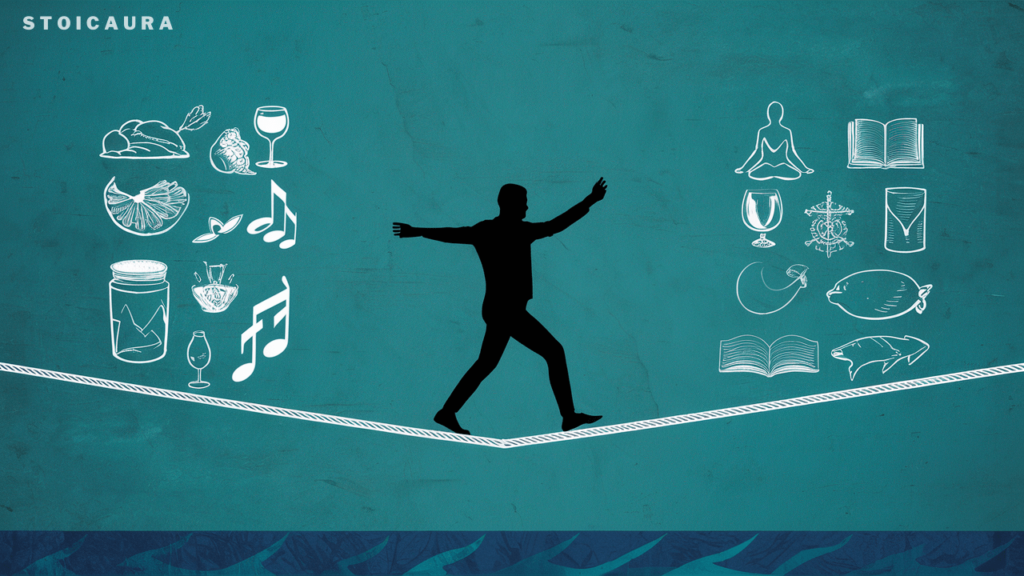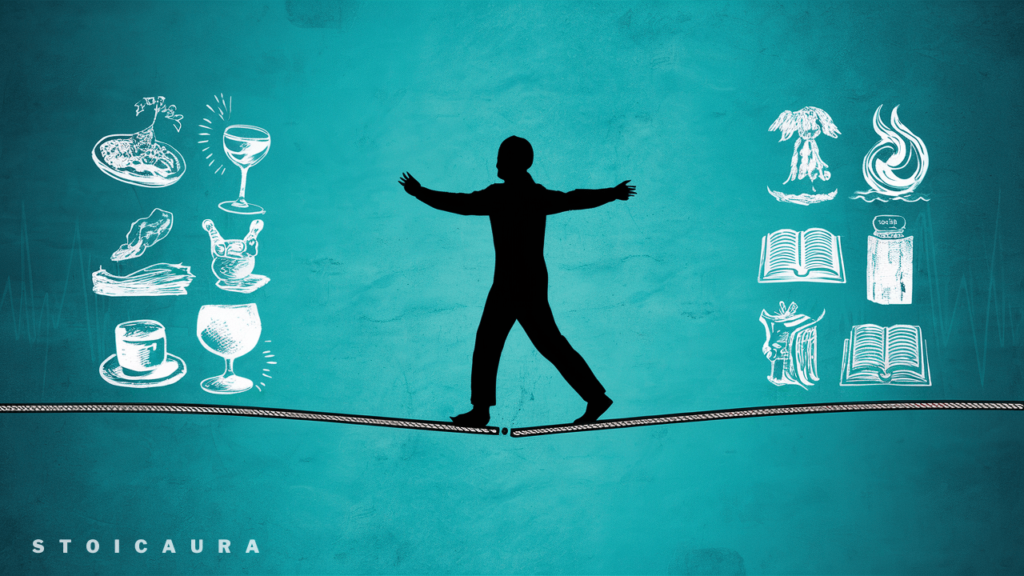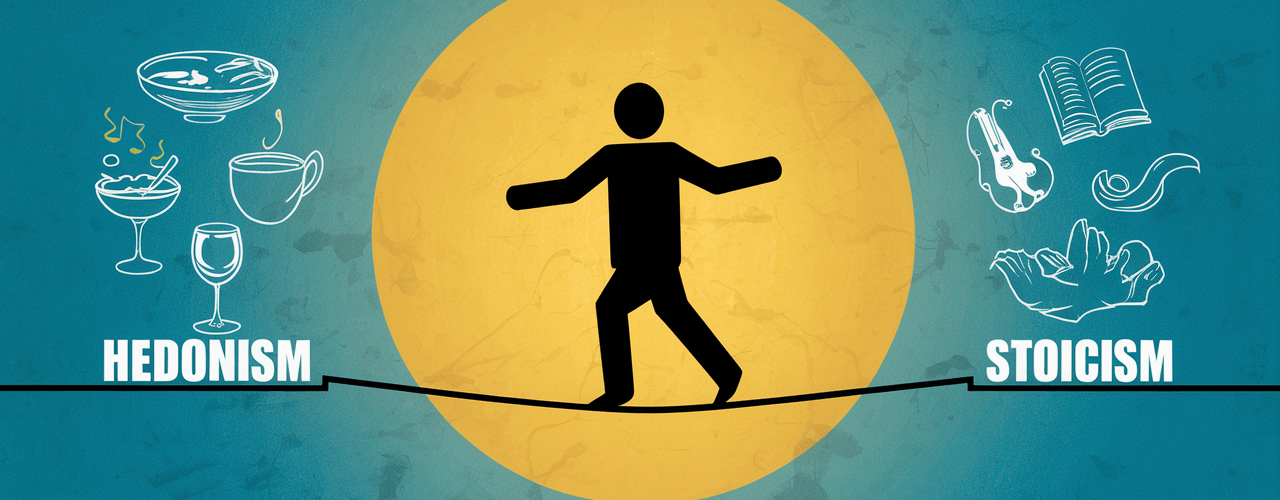
Introduction
In a world where the pursuit of happiness often seems like the ultimate quest, two ancient philosophies offer strikingly different paths: hedonism and stoicism. Picture this: on one hand, you have hedonism, the life of the party, urging you to savor every drop of pleasure life has to offer. On the other, there’s stoicism, the calm sage, advocating for a life of virtue and inner peace, regardless of external circumstances. But here’s the real kicker—both claim to hold the key to true happiness. So, which philosophy really leads to a fulfilling life?
As mindfulness and wellness enthusiasts, you’re no strangers to the challenge of finding genuine contentment in life. But have you ever wondered whether you’re more of a hedonist or a stoic at heart, or perhaps a mix of both? Dive into our exploration of hedonism versus stoicism and discover which philosophy might resonate more with your own journey towards happiness. We promise, it’s more than just an intellectual exercise—it’s a fresh lens through which to view your daily choices and long-term goals. Buckle up, because this could very well change the way you approach your pursuit of happiness. Let’s get started!
Defining the Battle: What Are Hedonism and Stoicism Really About?
When it comes to defining the philosophies that might just shape our pursuit of happiness, two standout contenders often pop up: Stoicism and Hedonism. These age-old philosophies are more than just fancy words; they are about choosing different routes on the map of life. Stoicism, for instance, teaches us the art of resilience—it’s all about maintaining a steady demeanor, no matter what life throws your way. Picture the calm, collected individual who views every setback as an opportunity to grow and every challenge as a chance to practice virtues like wisdom, bravery, and temperance. Stoics believe that true happiness isn’t found in external pleasures but in controlling one’s reactions and living in harmony with nature’s laws.
On the flip side, we have Hedonism, which often gets a bad rap as being all about indulgence. But, it’s not just about chasing fleeting pleasures; it’s a nuanced philosophy that argues the pursuit of pleasure and the avoidance of pain are the ultimate keys to a well-lived life. Imagine savoring the moments—whether that’s enjoying a stunning sunset or relishing a perfectly brewed cup of coffee. Hedonists see these pleasures as essential to increasing overall life satisfaction.
These philosophies challenge us to think about what really makes us happy. Is it about finding peace in the face of adversity, as the Stoics would suggest, or is it about embracing and seeking out joy, as the Hedonists believe? Each offers a unique lens through which to view our personal happiness quest, making the journey as rich as its destination.
The Hedonistic Route to Happiness: Is Pleasure Really Enough?
The journey towards happiness often stirs up a debate between contrasting philosophies, notably Stoicism and Hedonism. In the hedonistic perspective, pleasure stands as the cornerstone of a joyful life. But the big question is: Is pleasure really enough? Hedonism tells us to embrace life’s delights in full—every bite of a delicious meal, every laugh shared with friends, every luxury and comfort. This pursuit isn’t shallow, as critics of Hedonism might suggest; rather, it’s about maximizing well-being through experiences that bring joy.
Yet, while savoring these moments can elevate our spirits momentarily, solely relying on sensory pleasures might not suffice for long-term happiness. After all, pleasures can be fleeting, and hedonistic satisfaction often demands constant renewal to avoid a sense of emptiness. Enter Stoicism, which offers a stark contrast by advocating for inner tranquility and resilience, independent of external circumstances. Stoics would argue that true happiness derives from a sense of contentment that doesn’t hinge on the ups and downs of life’s pleasures and pains.
By intertwining insights from both Hedonism and Stoicism, perhaps we can forge a more sustainable path to happiness. This hybrid approach encourages enjoying life’s pleasures without becoming dependent on them, while also cultivating an inner strength that prepares us to face life’s inevitable challenges. Such a balanced view not only enriches our pursuit of happiness but also grounds us in a reality where joy and adversity coexist.

Stoicism’s Approach: Can Acceptance Lead to Greater Joy?
In the age-old debate between Stoicism and Hedonism, Stoicism presents a unique angle on happiness that veers away from the pursuit of pleasure. Instead, it champions acceptance and resilience as the pathways to a deeper, more sustainable form of joy. Stoicism doesn’t push us to seek happiness in the external world—quite the opposite. It teaches that true contentment comes from within, from accepting things as they are and focusing on what we can control: our thoughts and reactions. Consider the story of the Stoic philosopher who, when he lost everything, remarked that he had not lost his ability to respond virtuously.
This Stoic principle of acceptance might not sound as immediately gratifying as the hedonistic chase for pleasure, but it proposes a more grounded approach to life’s inevitable ups and downs. By cultivating an attitude of acceptance, Stoics argue that we can achieve a state of inner peace that’s largely immune to external circumstances. This doesn’t mean resigning ourselves to a joyless existence; rather, it’s about finding joy in resilience and in the freedom from being swayed by desires and aversions.
The beauty of Stoicism lies in its simplicity and its profound impact on mental health. By practicing Stoic principles, many find a surprising sense of liberation and joy in letting go of the need for constant external validation or pleasure. This approach might just be the steadier, albeit less flashy, route to a fulfilling and joyful life, offering a stark but complementary contrast to Hedonism’s more sensory-driven philosophy.
Real-Life Applications: Hedonism vs Stoicism in Everyday Decisions
When we look at Stoicism and Hedonism, it’s like comparing two radically different life coaches whispering in our ears as we navigate the ups and downs of daily life. Imagine you’re at a lavish buffet. The hedonistic approach would cheer you on to savor every possible delicacy, embracing the pleasure of the moment. “Go on, treat yourself!” it says, urging you to indulge in the sensory pleasures life offers. Hedonism isn’t just about indulgence though; it’s about appreciating and maximizing happiness in everyday experiences, advocating that this pursuit of pleasure can significantly boost our overall well-being.
On the other side, there’s Stoicism, which might encourage a more measured approach. Faced with the same buffet, Stoicism would advise mindfulness and restraint, focusing on the long-term benefits of good health and self-control rather than immediate gratification. “Is this what you need?” it asks, pushing you to consider whether your choices align with your values and long-term goals. This philosophy teaches that happiness comes from accepting the present and managing our desires and emotions, rather than letting them manage us.
Both philosophies offer valuable insights that can be applied in real-life scenarios, from how we handle a compliment to our reaction to traffic jams. Whether choosing Stoicism’s path of mindful acceptance or Hedonism’s route of embracing pleasure, each provides tools that can influence our decisions towards a more thoughtful and potentially fulfilling life. By recognizing the merits of both, we can perhaps strike a balance that enriches our day-to-day experiences.
The Verdict: Evaluating Which Philosophy Fosters True Contentment
Deciding which philosophy—Stoicism or Hedonism—better fosters true contentment is akin to choosing between two excellent but fundamentally different recipes for the same dish. Each promises satisfaction but caters to distinct tastes and sensibilities. Hedonism, with its core belief that pleasure is the highest good, encourages us to relish life’s offerings to the fullest. It’s like diving spoon-first into your favorite ice cream under the sun—pure, blissful indulgence. Yet, while Hedonism champions immediate joys, its pursuit can sometimes feel like a never-ending chase, potentially leading to a sense of emptiness when the pleasures fade.
Stoicism, on the other hand, equips us with tools to detach from our desires and maintain inner peace regardless of external circumstances. It’s like having a warm, sturdy shelter in a storm—safe and serene. This philosophy teaches that true contentment comes not from external sources, but from mastering our responses to whatever life throws our way. By advocating for resilience and virtue, Stoicism suggests that happiness is a state of mind, accessible at any moment, if we only adjust our perspective.
The real verdict on which philosophy fosters true contentment might just lie in a blend of both worlds. Perhaps the secret is learning when to indulge in life’s pleasures while also knowing how to remain equanimous in their absence. By integrating the joy-seeking spirit of Hedonism with the tranquil wisdom of Stoicism, we might find a more rounded, sustainable path to contentment—one that allows us to enjoy life’s highs and handle its lows with grace.

Conclusion
Our exploration of Hedonism and Stoicism reveals that the quest for true happiness is not a matter of choosing one path over the other, but rather understanding how each philosophy complements the other in the journey of life. Hedonism encourages us to embrace and seek joy in the pleasures of the moment, enhancing our daily experiences and overall satisfaction. Meanwhile, Stoicism equips us with the resilience to face life’s adversities, fostering an inner peace that is not easily shaken by external circumstances.
The key takeaway is that a balanced approach may indeed be the secret to sustained happiness. By integrating the pursuit of pleasure with a stoic acceptance of what we cannot change, we can enjoy the best of both worlds: the vibrancy and excitement of sensory experiences, paired with the tranquility and fortitude that come from stoic wisdom.
So, why not experiment with these philosophies in your own life? Start small by identifying moments for pure enjoyment and others for reflection and resilience. Perhaps this week, you could deliberately seek out a pleasure you’ve been denying yourself, and also practice reacting more stoically to an unexpected challenge.
As you blend Hedonism and Stoicism in your daily life, you might discover a richer, more textured kind of happiness—one that is both deeply fulfilling and enduringly peaceful. Let this exploration be your starting point to crafting a life of well-rounded contentment. Embrace the journey, and let your experiences guide you to your own true happiness.







